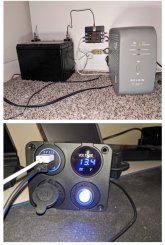I have just gone through the 2 coldest nights in nearly 100 yrs with no power, heat, water, or cell data service. That leaves the experience fresh on my mind. So I am proposing a set of specs for a project that would have been a HUGE help and I am asking for your advice on this project. Full disclosure, I am a rural Texan so this would also help me.
What I saw was that the power company outage information was only available on the internet and their web pages were very data heavy. Often impossible to load on a cell phone. All the up to date news was on web streams or digital TV. After the first night, the cell towers ran out of backup power and went offline. The roads were iced over and impassable. In essence we were sitting 13 miles from a mall in west Houston but were as cut off as if we were in back woods Siberia.
What I am planning, and need help/advice with, is a "Will Prowse milk crate" solution for long term backup of an internet & wifi connection. I have the routers and equipment and experience to do actual load measurements and then can calculate the number of Watt-Hours of storage needed. But I would have to spend a long time figuring out the best option for recharging, solar input (although minimal in our recent storm), and BMS. Any one who can help with that design and selection would be a big help.
Based on what I saw the system would need:
Anyone out there willing to help?
Thanks in advance for thoughts and support.
What I saw was that the power company outage information was only available on the internet and their web pages were very data heavy. Often impossible to load on a cell phone. All the up to date news was on web streams or digital TV. After the first night, the cell towers ran out of backup power and went offline. The roads were iced over and impassable. In essence we were sitting 13 miles from a mall in west Houston but were as cut off as if we were in back woods Siberia.
What I am planning, and need help/advice with, is a "Will Prowse milk crate" solution for long term backup of an internet & wifi connection. I have the routers and equipment and experience to do actual load measurements and then can calculate the number of Watt-Hours of storage needed. But I would have to spend a long time figuring out the best option for recharging, solar input (although minimal in our recent storm), and BMS. Any one who can help with that design and selection would be a big help.
Based on what I saw the system would need:
- Inverter to drive a dial up or dsl modem, a firewall/router (Ubiquiti Edge Lite or equiv), an ethernet switch, and a wireless access point or two. For TV a HDHomerun OTA TV to IP adapter. Also a Raspberry Pi with a 24 inch-ish monitor and headphones/bluetooth speaker. Other than the monitor everything else on that list should run on 10-20 watts each (or less).
- Battery storage to carry that equipment for up to 20 hours continuously.
- USB charger outputs for phones and ePaper tablets.
- Charger that could add 75-80% charge to the system in 1.5 hrs. and/or be charged from a car by using clamps to connect to the battery/alternator (limited to 600w max)
- Low self discharge (long shelf life) batteries with as much cycle life as possible (LiFePo?).
- All in one or two "milk crate" containers
- Everything we do fully open source and open hardware. Obviously some of the equipment will be commercial, but open source preferred when possible.
- Needs to be equally as useful in a 100F after hurricane day as it is in a 0F power crisis.
Anyone out there willing to help?
Thanks in advance for thoughts and support.



